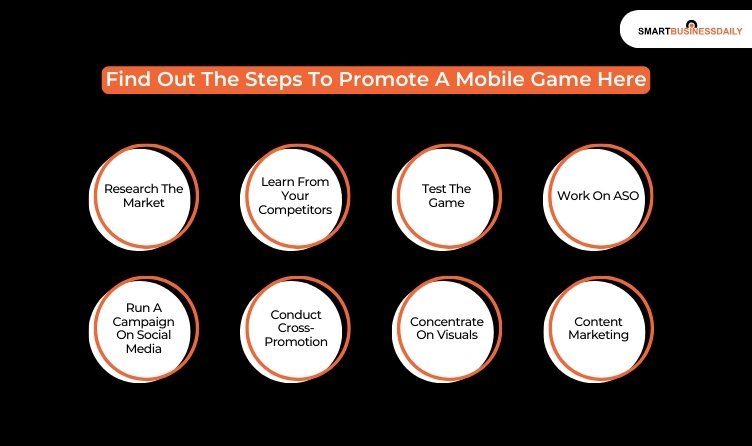How To Promote Mobile Games? A Step-By-Step Guide
4 Mins Read
Published on: 19 April 2022
Last Updated on: 11 September 2024

toc impalement
It took a long time to make a game in the early days of creation.
The game has to be written and coded from the ground up by the developers. Everything from the most essential pieces to the most complicated systems had to be coded.
And by everything, I mean everything.
We’ve seen a growth in video games, and this craze has spread to mobile gaming, which first became popular in Japan in the early 2000s. Europe and the United States required a few years to catch up with the trend.
The video gaming industry will expand to a $93 billion sector by 2024. The mobile gaming sector dominates the whole video game market. Mobile games are already a multibillion-dollar industry, with sales predicted to reach $56.6 billion by 2024.
If you have played those video games on thepirateproxybay.com, you must know the difference between them and mobile games. Hence, the tactics of promoting them are also different.
Find Out The Steps To Promote A Mobile Game Here:

Step 1: Research The Market
To prevent creating a game for an uninterested audience, thorough market research is required.
Find out what kinds of games are popular and what subcategories are popular.
Use trends.google.com to locate trending search phrases on Google, the world’s most popular search engine, if you’re performing research before building a game. It’s typically a decent sign of some interest.
If you’ve already created a game, research your competition.
Step 2: Learn From Your Competitors
You should develop a list of everything of interest when surfing to learn from your app competition. Take a look at various customer reviews.
Pay attention to the titles, screenshots, and descriptions of your competitors. Make a mental note of the screenplay for their video. Examine where and how they use keywords throughout their app listing.
Putting your mobile game up with the rest of the app forest isn’t enough to promote it. You must completely prepare yourself if you want to succeed.
And
Planning entails completing your study before making any decisions. After all, a game with more features has a higher chance of fame and money.
Step 3: Test The Game
Testing is something I always recommend.
Look at the statistics if you’re as unsure as I am. They are not deceitful.
Make sure to test your items and ensure they meet industry quality standards.
You want to fix as many bugs as possible before your scheduled launch date but should concentrate on poor game design flaws.
Step 4: Work On ASO
Mobile game advertising is challenging without effective app search optimization (ASO).
You’ll have the minimum experience necessary to tackle your mobile game’s ASO if you’ve studied and understood your competitor’s point of view. Almost 70% of mobile consumers use app store search to find new apps.
When you switch off your marketing initiatives, your game will vanish off your audience’s radar without organic traffic from the app stores.
Organic traffic is critical to the survival of any mobile game. The quantity of installations you may expect is directly proportional to your game’s ranking in the app store.
Step 5: Run A Campaign On Social Media
Use social media to run sponsored marketing.
You may market your mobile game on various social media networks, but the idea is to figure out what works best for your game and target your efforts appropriately.
You’ll need eye-catching artwork, gaming footage, and a compelling message.
Consider your target audience and what could pique their attention. These kinds of creatives are worthwhile even though they take time and money.
Step 6: Conduct Cross-Promotion
Cross-promotion is a cost-free method of promoting mobile games. You may cross-promote a mobile game in your other games or approach other creators to see if you can work anything out.
Cross-promote your games by looking for developers in related online communities.
Advertise in other mobile games and applications as another opportunity to cross-promote. As you may be aware, in-app advertising is a common monetization approach in which developers display advertisements in their app or game in exchange for ad money.
Step 7: Concentrate On Visuals
Videogames are visual heavy mediums. This means people interact with these games more in a visual setting. As a result, to popularise your game, you need to concentrate on the visual side of things.
Start by designing a captivating trailer that showcases the in-game gameplay. A CGI trailer works, but an in-game trailer is just better. It allows you to showcase everything that you have been working on.
Moreover, drop gameplay teases here and there. This would keep the fans engaged. Just follow what Rockstar Games is doing with GTA VI. But follow that to promote the mobile game that you have created.
Step 8: Content Marketing
Last but not least is content marketing. Content marketing is a vital tool to have. A proper content marketing campaign can help you quickly promote mobile games.
Create content based on the game and release it consistently. Keep track of your end goal. Therefore, do not go overboard and spoil the game altogether. Keep things mysterious but on the topic.
This is the only way you should proceed. Otherwise, nobody would like to play a spoiled game.
Final Takeaway
Today’s game technologies, such as Unity and Unreal Engine, enable current game creators to skip ahead and save a significant amount of time.
These engines drastically reduce game creation time, making more games available on marketplaces and app stores. In addition, the price of developing a mobile game on an existing framework will be lower, allowing you to increase your marketing budget.
Once you have increased your marketing budget, you can follow these steps to promote your game, and if you do these right, it will work!
Read Also:


















Comments Are Closed For This Article